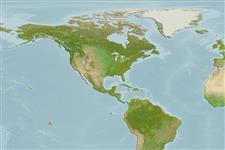>
Ovalentaria/misc (Various families in series Ovalentaria) >
Pomacentridae (Damselfishes) > Chrominae
Etymology: Dascyllus: Greek, daskillys, -on = a kind of fish (Ref. 45335).
Eponymy: Donald W Strasburg (1925–2008) was a fish ecologist at the University of Hawaii and at the Bureau of Commercial Fisheries Biological Laboratory, Honolulu and an environmentalist at the Naval Research Laboratory, Washington, DC. [...] (Ref. 128868), visit book page.
Environment: milieu / climate zone / profondeur / distribution range
Écologie
marin récifal; non migrateur; profondeur 5 - 15 m (Ref. 7247). Tropical; 5°S - 10°S
Eastern Central Pacific: endemic to the Marquesas Islands.
Taille / Poids / Âge
Maturité: Lm ? range ? - ? cm
Max length : 9.0 cm SL mâle / non sexé; (Ref. 7247)
Description synthétique
Clés d'identification | Morphologie | Morphométrie
Épines dorsales (Total) : 12; Rayons mous dorsaux (Total) : 15 - 16; Épines anales: 2; Rayons mous anaux: 14 - 15.
Body shape (shape guide): short and / or deep; Cross section: compressed.
Adults inhabit coral and rocky reefs. The two specimens at the Bishop Museum were collected off Matahumu Point, Patu Hiva, Marquesas Islands in 6 to 12 meters (Ref. 7247). Feeds on zooplanktons (Ref. 89972). Life history characteristics for the family specify that this group is oviparous, with distinct pairing during breeding (Ref. 205). Eggs are demersal and adhere to the substrate (Ref. 205). Males guard and aerate the eggs (Ref. 205). Diurnal species (Ref. 54980; 113699).
Life cycle and mating behavior
Maturité | Reproduction | Frai | Œufs | Fécondité | Larves
Life history characteristics for the family specify that this group is oviparous, with distinct pairing during breeding (Ref. 205). Eggs are demersal and adhere to the substrate (Ref. 205). Males guard and aerate the eggs (Ref. 205).
Allen, G.R., 1991. Damselfishes of the world. Mergus Publishers, Melle, Germany. 271 p. (Ref. 7247)
Statut dans la liste rouge de l'IUCN (Ref. 130435: Version 2025-1)
Menace pour l'homme
Harmless
Utilisations par l'homme
Outils
Articles particuliers
Télécharger en XML
Sources Internet
Estimates based on models
Preferred temperature (Réf.
123201): 27.9 - 28.1, mean 28.1 °C (based on 11 cells).
Phylogenetic diversity index (Réf.
82804): PD
50 = 0.5005 [Uniqueness, from 0.5 = low to 2.0 = high].
Bayesian length-weight: a=0.02089 (0.00944 - 0.04623), b=2.98 (2.80 - 3.16), in cm total length, based on LWR estimates for this (Sub)family-body shape (Ref.
93245).
Niveau trophique (Réf.
69278): 3.0 ±0.2 se; based on size and trophs of closest relatives
Résilience (Réf.
120179): Haut, temps minimum de doublement de population inférieur à 15 mois (Preliminary K or Fecundity.).
Fishing Vulnerability (Ref.
59153): Low vulnerability (10 of 100).
🛈
Nutrients (Ref.
124155): Calcium = 126 [61, 211] mg/100g; Iron = 0.875 [0.503, 1.482] mg/100g; Protein = 18.2 [16.9, 19.3] %; Omega3 = 0.113 [0.062, 0.198] g/100g; Selenium = 19 [9, 40] μg/100g; VitaminA = 168 [48, 587] μg/100g; Zinc = 1.65 [1.07, 2.46] mg/100g (wet weight);
